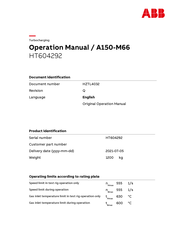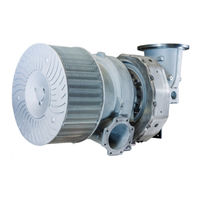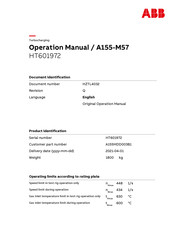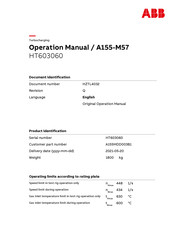ABB A155-M57 Manuals
Manuals and User Guides for ABB A155-M57. We have 22 ABB A155-M57 manuals available for free PDF download: Instruction Manual, Operation Manual, Manual
ABB A155-M57 Operation Manual (196 pages)
Brand: ABB
|
Category: Industrial Equipment
|
Size: 33 MB
Table of Contents
-
-
Safety15
-
Introduction15
-
Intended Use17
-
Oil Supply41
-
Service Work54
-
Introduction87
Advertisement
ABB A155-M57 Operation Manual (196 pages)
Brand: ABB
|
Category: Industrial Equipment
|
Size: 33 MB
Table of Contents
-
-
Safety15
-
Introduction15
-
Intended Use17
-
Oil Supply41
-
Service Work54
-
Introduction87
ABB A155-M57 Operation Manual (196 pages)
Brand: ABB
|
Category: Industrial Equipment
|
Size: 33 MB
Table of Contents
-
-
Safety15
-
Introduction15
-
Intended Use17
-
Oil Supply41
-
Service Work54
-
Introduction87
Advertisement
ABB A155-M57 Operation Manual (196 pages)
Turbocharging
Brand: ABB
|
Category: Industrial Equipment
|
Size: 33 MB
Table of Contents
-
-
Safety15
-
Introduction15
-
Intended Use17
-
Oil Supply41
-
Service Work54
-
Introduction87
ABB A155-M57 Operation Manual (196 pages)
Brand: ABB
|
Category: Industrial Equipment
|
Size: 33 MB
Table of Contents
-
-
Safety15
-
Introduction15
-
Intended Use17
-
Oil Supply41
-
Service Work54
-
Introduction87
ABB A155-M57 Operation Manual (196 pages)
Brand: ABB
|
Category: Industrial Equipment
|
Size: 33 MB
Table of Contents
-
-
Safety15
-
Introduction15
-
Intended Use17
-
Oil Supply41
-
Service Work54
-
Introduction87
ABB A155-M57 Operation Manual (196 pages)
Brand: ABB
|
Category: Industrial Equipment
|
Size: 33 MB
Table of Contents
-
-
Safety15
-
Introduction15
-
Intended Use17
-
Oil Supply41
-
Service Work54
-
Introduction87
ABB A155-M57 Operation Manual (196 pages)
Brand: ABB
|
Category: Industrial Equipment
|
Size: 33 MB
Table of Contents
-
-
Safety15
-
Introduction15
-
Intended Use17
-
Oil Supply41
-
Service Work54
-
Introduction87
ABB A155-M57 Operation Manual (196 pages)
Table of Contents
-
-
Safety15
-
Introduction15
-
Intended Use17
-
Oil Supply41
-
Service Work54
-
Introduction87
ABB A155-M57 Operation Manual (196 pages)
Brand: ABB
|
Category: Industrial Equipment
|
Size: 33 MB
Table of Contents
-
-
Safety15
-
Introduction15
-
Intended Use17
-
Oil Supply41
-
Service Work54
-
Introduction87
ABB A155-M57 Operation Manual (196 pages)
Turbocharging
Brand: ABB
|
Category: Industrial Equipment
|
Size: 33 MB
Table of Contents
-
-
Safety15
-
Introduction15
-
Intended Use17
-
Oil Supply41
-
Service Work54
-
Introduction87
ABB A155-M57 Instruction Manual (202 pages)
Brand: ABB
|
Category: Industrial Equipment
|
Size: 31 MB
Table of Contents
-
Safety
11-
Safety12
-
Intended Use14
-
-
Introduction32
-
Introduction34
-
Oil Supply50
-
Service Work63
-
Introduction96
-
Fig. 87: S_05180151
-
Disassembly173
-
Assembly176
-
Spare Parts188
-
Tools195
-
ABB A155-M57 Operation Manual (200 pages)
Brand: ABB
|
Category: Industrial Equipment
|
Size: 34 MB
Table of Contents
-
-
Safety15
-
Introduction15
-
Intended Use17
-
Oil Supply42
-
Service Work55
-
Introduction91
-
Fig. 95: S_05180144
-
Disassembly164
-
Assembly167
-
Spare Parts180
-
Tools194
ABB A155-M57 Operation Manual (200 pages)
Turbocharging
Brand: ABB
|
Category: Industrial Equipment
|
Size: 34 MB
Table of Contents
-
-
Safety15
-
Introduction15
-
Intended Use17
-
Oil Supply42
-
Service Work55
-
Introduction91
-
Fig. 95: S_05180144
-
Disassembly164
-
Assembly167
-
Spare Parts180
-
Tools194
ABB A155-M57 Operation Manual (200 pages)
Brand: ABB
|
Category: Industrial Equipment
|
Size: 34 MB
Table of Contents
-
-
Safety15
-
Introduction15
-
Intended Use17
-
Oil Supply42
-
Service Work55
-
Introduction91
-
Fig. 95: S_05180144
-
Disassembly164
-
Assembly167
-
Spare Parts180
-
Tools194
ABB A155-M57 Operation Manual (200 pages)
Brand: ABB
|
Category: Industrial Equipment
|
Size: 34 MB
Table of Contents
-
-
Safety15
-
Introduction15
-
Intended Use17
-
Oil Supply42
-
Service Work55
-
Introduction91
-
Fig. 95: S_05180144
-
Disassembly164
-
Assembly167
-
Spare Parts180
-
Tools194
ABB A155-M57 Manual (200 pages)
Brand: ABB
|
Category: Industrial Equipment
|
Size: 34 MB
Table of Contents
-
-
Safety15
-
Introduction15
-
Intended Use17
-
Oil Supply42
-
Service Work55
-
Introduction91
-
Fig. 95: S_05180144
-
Disassembly164
-
Assembly167
-
Spare Parts180
-
Tools194
ABB A155-M57 Operation Manual (202 pages)
Brand: ABB
|
Category: Battery Charger
|
Size: 31 MB
Table of Contents
-
Safety12
-
Intended Use14
-
Introduction32
-
Introduction34
-
Oil Supply50
ABB A155-M57 Operation Manual (200 pages)
Turbocharging
Brand: ABB
|
Category: Industrial Equipment
|
Size: 34 MB
Table of Contents
-
Safety15
-
Introduction15
-
Intended Use17
-
Oil Supply42
ABB A155-M57 Operation Manual (200 pages)
Turbocharging
Brand: ABB
|
Category: Industrial Equipment
|
Size: 34 MB
Table of Contents
-
Safety15
-
Introduction15
-
Intended Use17
-
Oil Supply42
ABB A155-M57 Operation Manual (200 pages)
Brand: ABB
|
Category: Battery Charger
|
Size: 34 MB
Table of Contents
-
Safety15
-
Introduction15
-
Intended Use17
-
Oil Supply42
ABB A155-M57 Operation Manual (200 pages)
Brand: ABB
|
Category: Industrial Equipment
|
Size: 31 MB
Table of Contents
-
Safety
11-
Safety12
-
Intended Use14
-
-
Introduction32
-
Introduction34
-
Oil Supply50
-
Service Work63
-
Introduction96
-
Fig. 87: S_05180151
-
Disassembly173
-
Assembly176
-
Spare Parts188
-
Advertisement





















